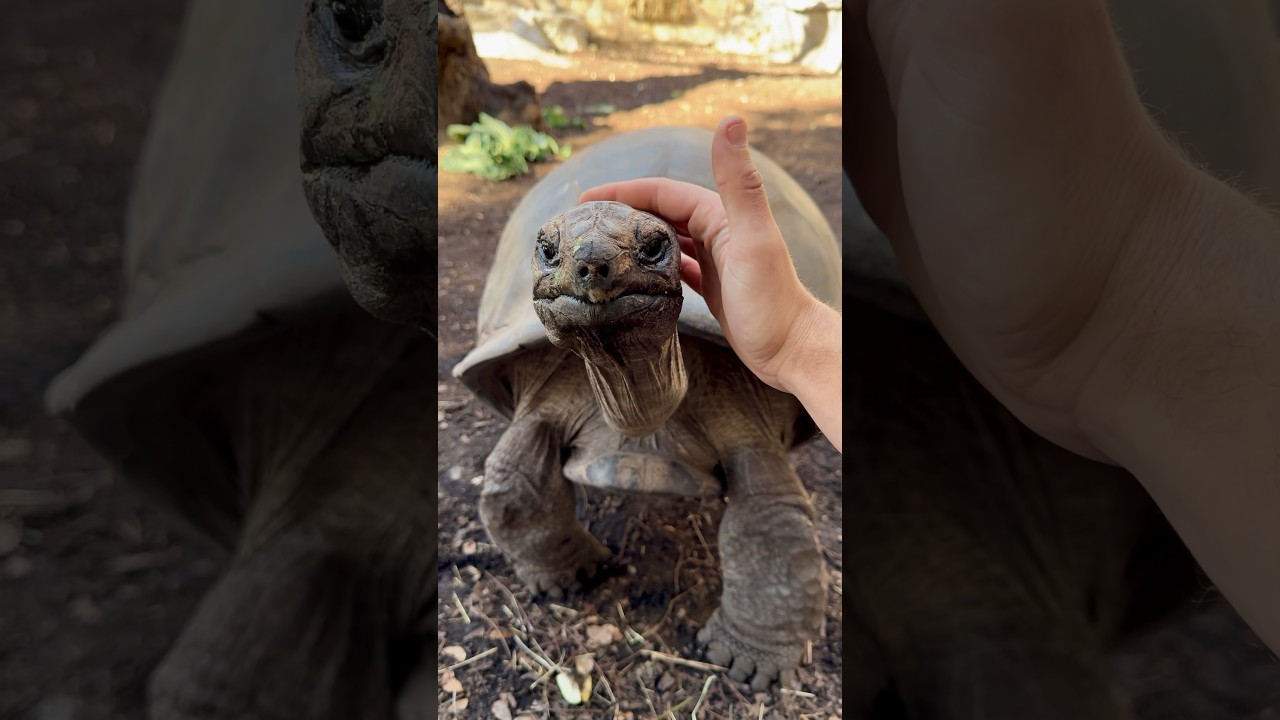– The surprisingly affectionate behavior of tortoises and their capacity for tactile enjoyment.
– The social and physical benefits of interaction between humans and reptiles.
– Insights into the lives of tortoises, their care, and the enrichment activities that enhance their well-being.
At first glance, the ancient, shelled beings we call tortoises may seem like stoic survivors from a bygone era. Their slow gait and seemingly impassive demeanor might mislead one to think they experience life at a more sedate, detached pace. However, delve a bit deeper into the world of these reptiles, and you’ll unearth a trove of fascinating behaviors and engaging social interactions. Among these is the delightfully heartwarming ritual of a tortoise enjoying a good shell scratch—much like Edie the tortoise, who has captivated many with her apparent love for affectionate touches from her caretaker.
The lines between cold-blooded creatures and responsive, sentient beings blur in such moments. Watching Edie extend her neck and direct her body towards her favorite scratching fingers, one can’t help but reassess their perceptions of reptilian emotion. This is an exploration of the layers beneath their scales, a deeper look at the connections possible between humans and their shelled companions.
Those who share their lives with tortoises often speak of distinct personalities shining through armor-like exteriors. Like any other pet, each tortoise has a unique disposition—some shy and retiring, others outgoing and curious. Edie seems to fall into the latter category, actively seeking interaction in a manner some might consider distinctly un-reptilian.
It’s worth noting that while tortoises can’t form facial expressions in the way humans or even other animals like dogs can, they do communicate in subtle ways. Some researchers and keepers suggest that a tortoise pushing against a hand or an object is expressing a type of pleasure. Their behavior, as observed in Edie, could indicate enjoying tactile sensations like shell scratches. Their shell, after all, is laden with nerve endings, and stimulation in the form of touch can be quite soothing or stimulating for them.
Moreover, such engagement isn’t just a one-way street catering to the whims of their human friends. It’s believed to provide enrichment—stimulating the environment necessary for their cognitive and physical health. For creatures living in human care, aside from their natural habitats, enrichment is pivotal in ensuring their well-being is as robust as possible.
Venturing further into a tortoise’s life, we find many more layers to peel back. With lifespans that can exceed a century, these animals carry history in their rings, much like the grandest trees. They witness the change of seasons, climates, and landscapes, albeit from their unique, low-to-the-ground perspective. The tales they could tell!
Their care, too, mirrors this complexity. Caring for a tortoise is not the same as caring for a cat or dog. It is a commitment that spans generations, with specific dietary needs and carefully regulated environmental conditions. They have preferences for temperature, light, and humidity that are as precise as the finest culinary recipe.
For instance, understanding their dietary requirements entails recognizing their status as herbivores, often needing a diet rich in fiber and low in proteins. Foods like dandelions, clovers, and various lettuces compose their meals, all to ensure they don’t develop health issues common to captive tortoises, such as pyramiding on the shell due to improper nutrition.
Much like other pets, who would take to a brush or a belly rub, tortoises such as Edie seem to find solace in the gentle scratch of their shell—which, despite being a tough protector against predators and elements, also provides a canvas for human affection. While some may tank up under their domes when approached, others will recognize the touch of a trusted friend and extend their leathery necks in anticipation of a good scratch. This behavior isn’t just adorable—it sparks questions about these ancient creatures’ sensitivity and social capacities.
Beneath the surface of these interactions lies yet another truth, often unspoken yet clearly demonstrated in Edie’s contented posture—a trust has been established. To let one’s guard down, to permit access to what is essentially an extension of their spine, the tortoise exhibits confidence in their environment and, more profoundly, in their human counterpart.
As we revel in the joy found in the simple act of scratching a tortoise’s shell, we must also acknowledge our responsibility to these companions. Their existence predates ours by millions of years, yet their continued survival, particularly in the wild, is uncertain. Habitat destruction, illegal pet trade, and climate change threaten tortoise populations worldwide, making conservation efforts in zoos, sanctuaries, and in-situ projects more critical than ever.
Conservation efforts often employ a multifaceted approach that includes breeding programs, research, public education, and habitat restoration. Informing the public and engaging them in the successes and challenges of initiatives like breeding the critically endangered radiated tortoise or the majestic Galápagos giant tortoise can foster a sense of connection that resonates deeper than a mere fascination.
Scratches on a tortoise’s shell can be more than a moment of connection; they can be a window into understanding and appreciating these extraordinary creatures. They remind us that life, in all its forms, seeks to survive and thrive. As Edie enjoys her interactions, we should be inspired to consider how we, as humans, affect the lives of tortoises and their kin across the globe. Whether through conservation, education or simply learning to offer a gentle scratch when needed, every action can contribute to a future where tortoises continue to lumber along Earth’s landscapes.
In our zeal to share and inspire, we perhaps find Edie the tortoise’s most profound lesson: that affection and care know no bounds, not by species or scale. These acts, as minute as they can be, embody a universal language that nurtures bonds across all walks of life. Let us bask in that warmth—together with our shelled companions, splendid in their old-world charm—beneath the shared sun of a world that will always be more wondrous when it is wild.
*****
Source Description


